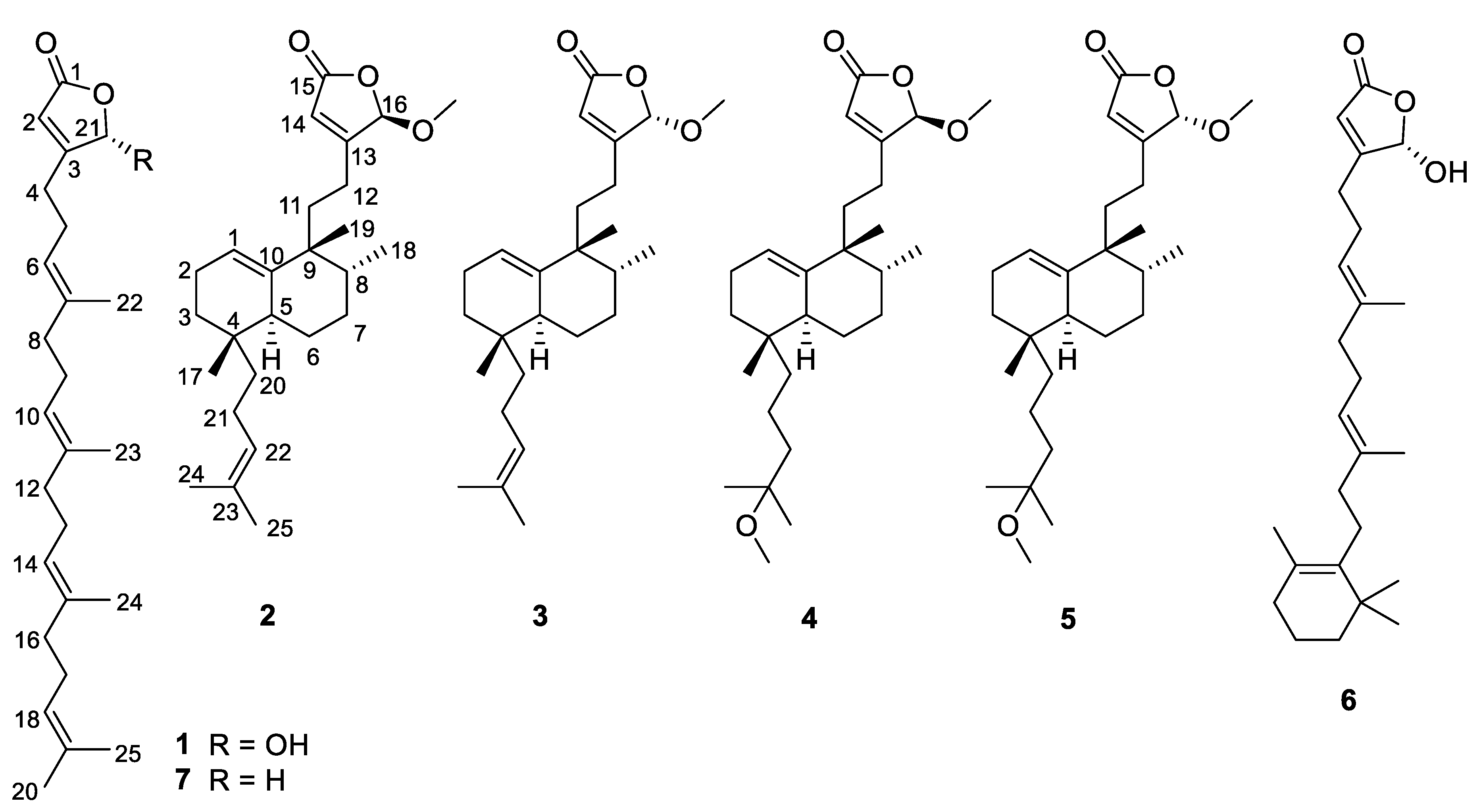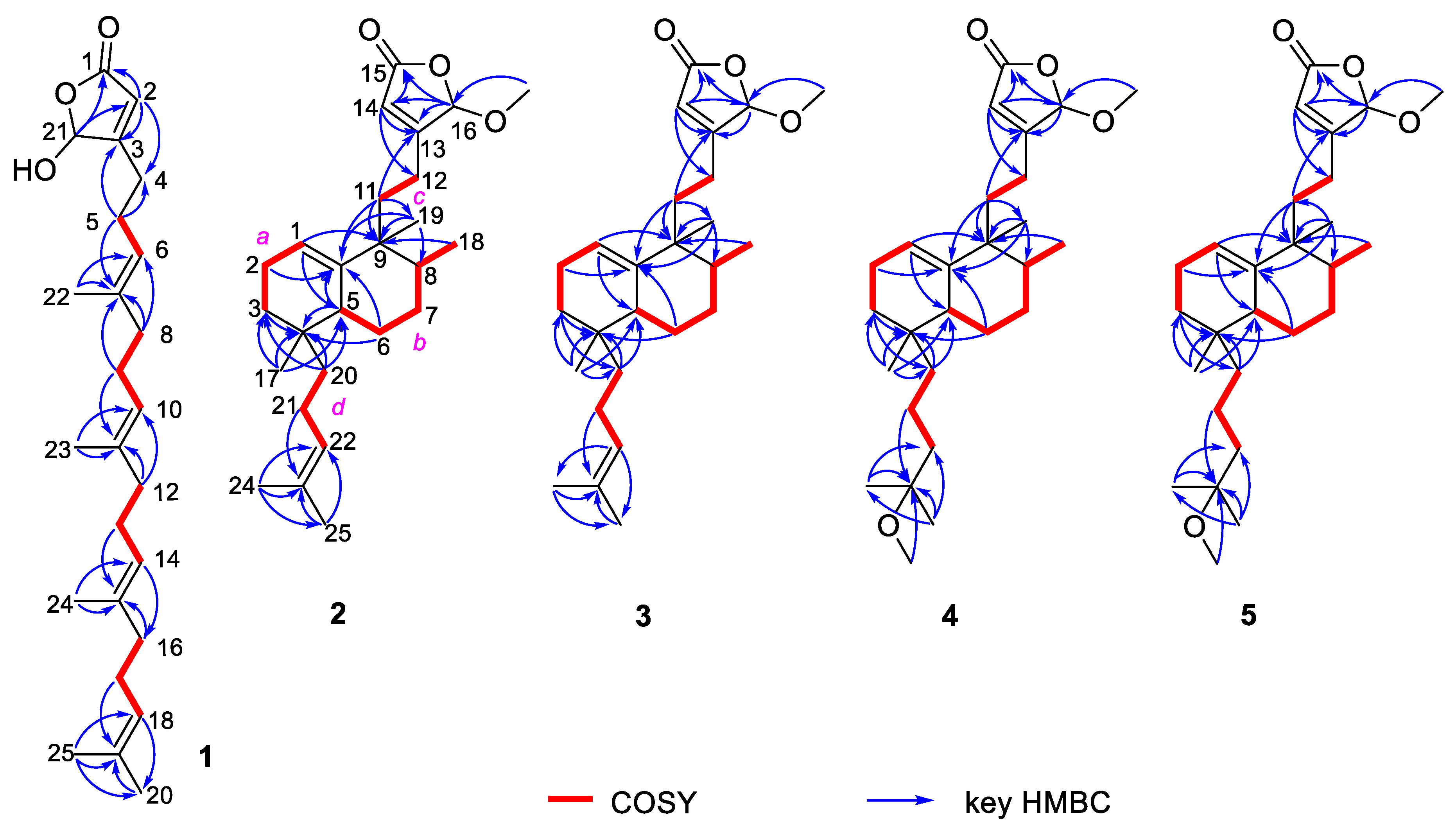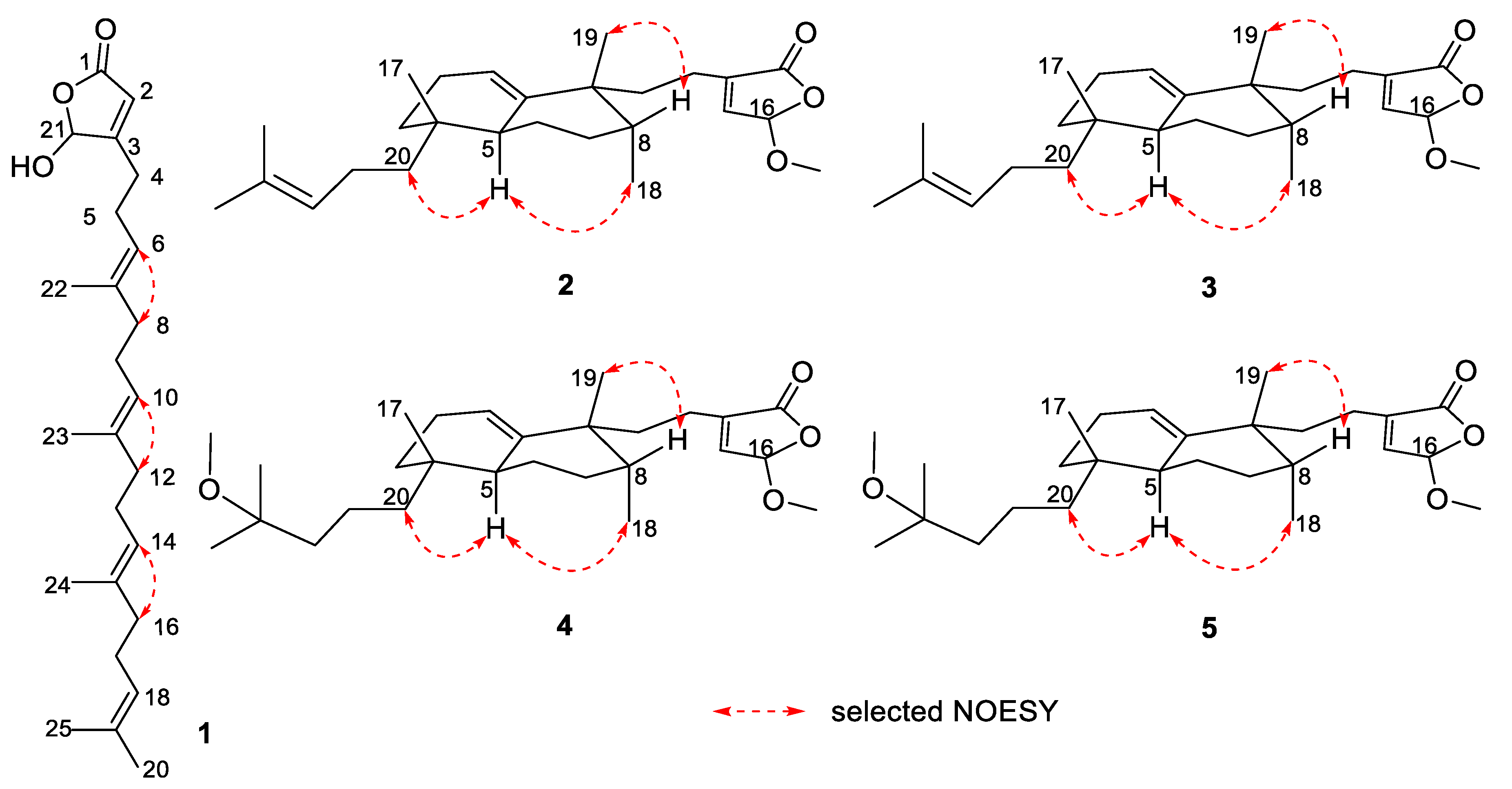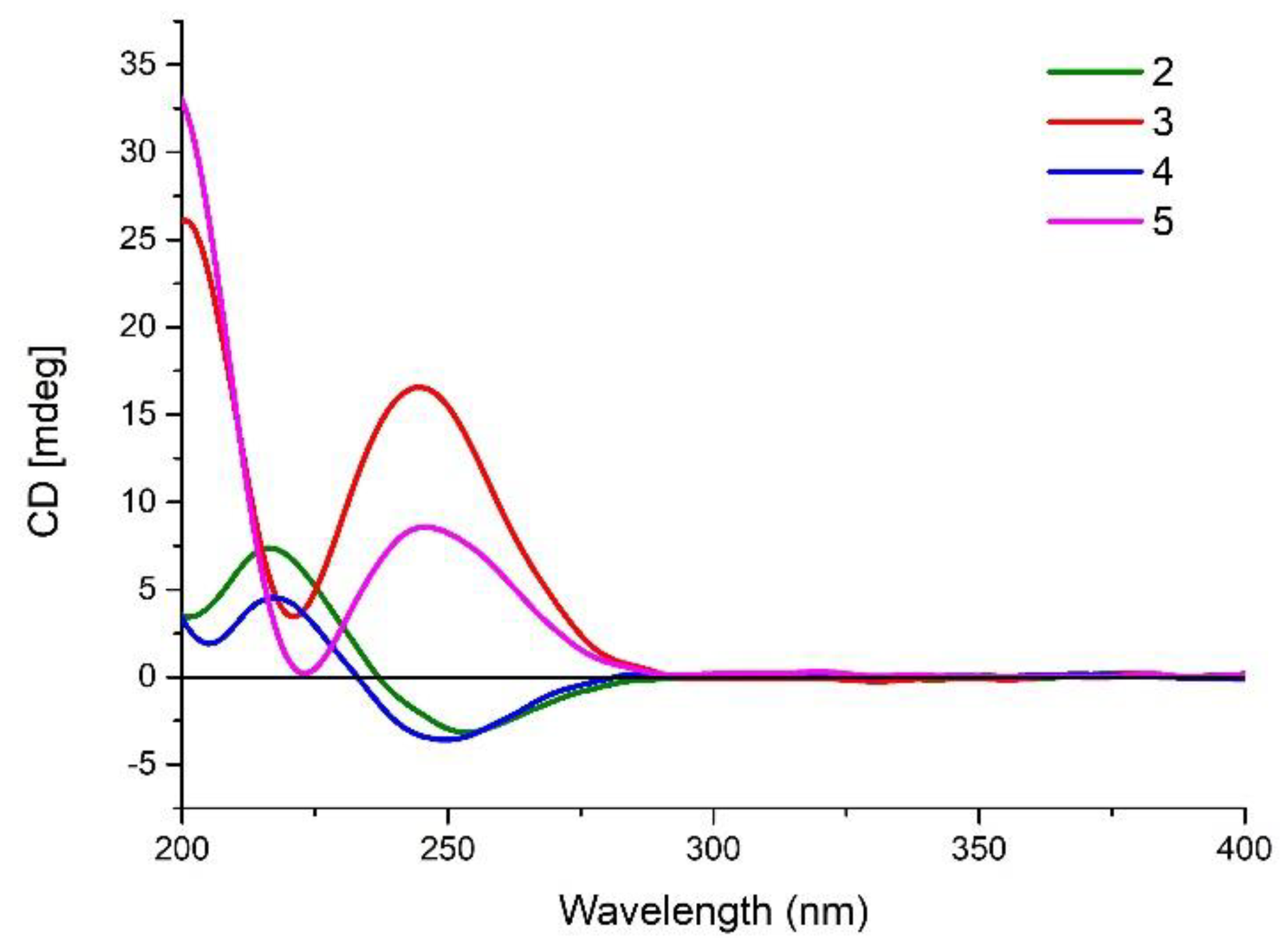Dactylospenes A–E, Sesterterpenes from the Marine Sponge Dactylospongia elegans
Abstract
:1. Introduction
2. Results
3. Experimental Section
3.1. General Experimental Procedures
3.2. Animal Material
3.3. Fermentation, Extraction, and Isolation
3.4. ECD Calculations
3.5. Biological Assays
4. Conclusions
Supplementary Materials
Author Contributions
Funding
Conflicts of Interest
References
- Huang, A.C.; Kautsar, S.A.; Hong, Y.J.; Medema, M.H.; Bond, A.D.; Tantillo, D.J.; Osbourn, A. Unearthing a sesterterpene biosynthetic repertoire in the Brassicaceae through genome mining reveals convergent evolution. Proc. Natl. Acad. Sci. USA 2017, 114, E6005–E6014. [Google Scholar] [CrossRef] [PubMed] [Green Version]
- Máximo, P.; Lourenço, A. Marine Sesterterpenes: An Overview. Curr. Org. Chem. 2018, 22, 2381–2393. [Google Scholar] [CrossRef]
- Khushi, S.; Nahar, L.; Salim, A.A.; Capon, R.J. Cacolides: Sesterterpene Butenolides from a Southern Australian Marine Sponge, Cacospongia sp. Mar. Drugs 2018, 16, 456. [Google Scholar] [CrossRef] [PubMed] [Green Version]
- Ebada, S.S.; Lin, W.; Proksch, P. Bioactive sesterterpenes and triterpenes from marine sponges: Occurrence and pharmacological significance. Mar. Drugs 2010, 8, 313–346. [Google Scholar] [CrossRef] [PubMed] [Green Version]
- Wang, J.; Jiao, W.H.; Huang, J.; Wang, J.H.; Lin, H.W. Advances in studies on chemical constituents in marine sponges of genus Dactylospongia and their bioactivities. Chin. J. Mar. Drugs 2016, 35, 103–110. [Google Scholar]
- Yu, H.-B.; Yin, Z.-F.; Gu, B.-B.; Zhang, J.-P.; Wang, S.-P.; Yang, F.; Lin, H.-W. Cytotoxic meroterpenoids from the marine sponge Dactylospongia elegans. Nat. Prod. Res. 2019. [Google Scholar] [CrossRef] [PubMed]
- Yu, H.-B.; Gu, B.-B.; Wang, S.-P.; Cheng, C.-W.; Yang, F.; Lin, H.-W. New diterpenoids from the marine sponge Dactylospongia elegans. Tetrahedron 2017, 73, 6657–6661. [Google Scholar] [CrossRef]
- Li, J.; Wang, Z.; Yang, F.; Jiao, W.H.; Lin, H.W.; Xu, S.H. Two new steroids with cytotoxicity from the marine sponge Dactylospongia elegans collected from the South China Sea. Nat. Prod. Res. 2018, 33, 1340–1344. [Google Scholar] [CrossRef] [PubMed]
- Li, J.; Yang, F.; Wang, Z.; Wu, W.; Liu, L.; Wang, S.P.; Zhao, B.X.; Jiao, W.H.; Xu, S.H.; Lin, H.W. Unusual anti-inflammatory meroterpenoids from the marine sponge Dactylospongia sp. Org. Biomol. Chem. 2018, 16, 6773–6782. [Google Scholar] [CrossRef] [PubMed]
- Hagiwara, K.; Garcia Hernandez, J.E.; Harper, M.K.; Carroll, A.; Motti, C.A.; Awaya, J.; Nguyen, H.-Y.; Wright, A.D. Puupehenol, a Potent Antioxidant Antimicrobial Meroterpenoid from a Hawaiian Deep-Water Dactylospongia sp. Sponge. J. Nat. Prod. 2015, 78, 325–329. [Google Scholar] [CrossRef] [PubMed]
- Daletos, G.; de Voogd, N.J.; Mueller, W.E.G.; Wray, V.; Lin, W.; Feger, D.; Kubbutat, M.; Aly, A.H.; Proksch, P. Cytotoxic and Protein Kinase Inhibiting Nakijiquinones and Nakijiquinols from the Sponge Dactylospongia metachromia. J. Nat. Prod. 2014, 77, 218–226. [Google Scholar] [CrossRef] [PubMed]
- Fattorusso, E.; Lanzotti, V.; Magno, S.; Mayol, L.; Rosa, M.D.; Ialenti, A. Linear sesterterpenes from the Caribbean sponge Thorecta horridus with inflammatory activity. Bioorg. Med. Chem. Lett. 1991, 1, 639–644. [Google Scholar] [CrossRef]
- Torii, M.; Kato, H.; Hitora, Y.; Angkouw, E.D.; Mangindaan, R.E.P.; de Voogd, N.J.; Tsukamoto, S. Lamellodysidines A and B, Sesquiterpenes Isolated from the Marine Sponge Lamellodysidea herbacea. J. Nat. Prod. 2017, 80, 2536–2541. [Google Scholar] [CrossRef] [PubMed]
- Albizati, K.F.; Holman, T.; Faulkner, D.J.; Glaser, K.B.; Jacobs, R.S. Luffariellolide, an Anti-inflammatory Sesterterpene from the Marine Sponge Luffariella sp. Experientia 1987, 43, 949–950. [Google Scholar] [CrossRef]
- Li, J.; Gu, B.-B.; Sun, F.; Xu, J.-R.; Jiao, W.-H.; Yu, H.-B.; Han, B.-N.; Yang, F.; Zhang, X.-C.; Lin, H.-W. Sesquiterpene Quinones/Hydroquinones from the Marine Sponge Spongia pertusa Esper. J. Nat. Prod. 2017, 80, 1436–1445. [Google Scholar] [CrossRef] [PubMed]
- Clinical and Laboratory Standards Institute. Reference Method for Broth Dilution Antifungal Susceptibility Testing of Yeast. In Approved Standard, 3rd ed.; Document M27-A3; Clinical and Laboratory Standards Institute: Wayne, PA, USA, 2009. [Google Scholar]
- Jiao, W.-H.; Li, J.; Liu, Q.; Xu, T.-T.; Shi, G.-H.; Yu, H.-B.; Yang, F.; Han, B.-N.; Li, M.; Lin, H.-W. Dysidinoid A, an unusual meroterpenoid with anti-MRSA activity from the South China Sea sponge Dysidea sp. Molecules 2014, 19, 18025–18032. [Google Scholar] [CrossRef] [PubMed] [Green Version]
- Yu, H.-B.; Wang, X.-L.; Zhang, Y.-X.; Xu, W.-H.; Zhang, J.-P.; Zhou, X.-Y.; Lu, X.-L.; Liu, X.-Y.; Jiao, B.-H. Libertellenones O–S and Eutypellenones A and B, Pimarane Diterpene Derivatives from the Arctic Fungus Eutypella sp. D-1. J. Nat. Prod. 2018, 81, 1553–1560. [Google Scholar] [CrossRef] [PubMed]
- Chen, S.; Deng, Y.; Yan, C.; Wu, Z.; Guo, H.; Liu, L.; Liu, H. Secondary Metabolites with Nitric Oxide Inhibition from Marine-Derived Fungus Alternaria sp. 5102. Mar. Drugs 2020, 18, 426. [Google Scholar] [CrossRef] [PubMed]





| Position | δC | δH, Mult. (J in Hz) | Position | δC | δH, Mult. (J in Hz) |
|---|---|---|---|---|---|
| 1 | 171.6, C | 14 | 124.2, CH | 5.11, q (6.4) c | |
| 2 | 117.6, CH | 5.85, s | 15 | 135.0, C | |
| 3 | 169.5, C | 16 | 39.6, CH2 a | 2.00, m c | |
| 4 | 27.8, CH2 | 2.46, brd (30.8) | 17 | 26.5, CH2 b | 2.06, m c |
| 5 | 25.2, CH2 | 2.32, m | 18 | 123.9, CH | 5.11, q (6.4) c |
| 6 | 121.9, CH | 5.11, q (6.4) c | 19 | 131.3, C | |
| 7 | 137.4, C | 20 | 25.7, CH3 | 1.60, s c | |
| 8 | 39.7, CH2 a | 2.00, m c | 21 | 99.1, CH | 6.00, s |
| 9 | 26.8, CH2 b | 2.06, m c | 22 | 17.7, CH3 | 1.63, s c |
| 10 | 124.4, CH | 5.11, q (6.4) c | 23 | 16.0, CH3 | 1.60, s c |
| 11 | 135.3, C | 24 | 16.3, CH3 | 1.60, s c | |
| 12 | 39.7, CH2 a | 2.00, m c | 25 | 16.2, CH3 | 1.68, s c |
| 13 | 26.6, CH2 b | 2.06, m c |
| Position | 2 | 3 | ||
|---|---|---|---|---|
| δC | δH, Mult. (J in Hz) | δC | δH, Mult. (J in Hz) | |
| 1 | 117.9, CH | 5.43, dd (4.2, 2.4) | 118.4, CH | 5.43, dd (4.2, 2.4) |
| 2 | 22.4, CH2 | 2.03, m | 22.9, CH2 | 2.03, m |
| 3a | 28.7, CH2 | 1.23, m | 28.5, CH2 | 1.23, m |
| 3b | 1.41, m | 1.41, m | ||
| 4 | 33.2, C | 33.9, C | ||
| 5 | 41.8, CH | 1.59, m | 42.5, CH | 1.59, m |
| 6a | 29.4, CH2 | 1.13, m | 29.9, CH2 | 1.13, m |
| 6b | 1.82, m | 1.82, m | ||
| 7a | 30.8, CH2 | 1.44, m | 31.3, CH2 | 1.44, m |
| 7b | 1.61, m | 1.61, m | ||
| 8 | 43.9, CH | 1.34, m | 44.4, CH | 1.34, m |
| 9 | 42.0, C | 43.1, C | ||
| 10 | 144.4, C | 145.0, C | ||
| 11a | 27.5, CH2 | 1.35, m | 28.2, CH2 | 1.35, m |
| 11b | 1.91, m | 1.91, m | ||
| 12a | 21.7, CH2 | 2.00, m | 22.3, CH2 | 2.00, m |
| 12b | 2.18, m | 2.18, m | ||
| 13 | 168.6, C | 169.1, C | ||
| 14 | 116.9, CH | 5.86, s | 117.5, CH | 5.86, s |
| 15 | 170.3, C | 170.8, C | ||
| 16 | 103.9, CH | 5.56, s | 104.4, CH | 5.61, s |
| 16-OCH3 | 56.1, CH3 | 3.53, s | 56.5, CH3 | 3.50, s |
| 17 | 23.5, CH3 | 0.86, s | 23.9, CH3 | 0.84, s |
| 18 | 15.9, CH3 | 0.88, d (7.2) | 16.4, CH3 | 0.84, d (6.6) |
| 19 | 22.4, CH3 | 1.06, s | 23.0, CH3 | 1.04, s |
| 20a | 38.6, CH2 | 1.12, m | 39.1, CH2 | 1.02, m |
| 20b | 1.33, m | 1.39, m | ||
| 21 | 21.9, CH2 | 1.86, m | 22.4, CH2 | 1.90, m |
| 22 | 124.6, CH | 5.01, t (7.2) | 125.2, CH | 5.04, t (7.2) |
| 23 | 130.9, C | 130.9, C | ||
| 24 | 17.2, CH3 | 1.58, s | 17.6, CH3 | 1.59, s |
| 25 | 25.2, CH3 | 1.68, s | 25.7, CH3 | 1.66, s |
| Position | 4 | 5 | ||
|---|---|---|---|---|
| δC | δH, Mult. (J in Hz) | δC | δH, Mult. (J in Hz) | |
| 1 | 118.0, CH | 5.44, t (3.6) | 118.5, CH | 5.41, t (3.6) |
| 2 | 22.4, CH2 | 1.99, m | 23.0, CH2 | 1.98, m |
| 3a | 28.6, CH2 | 1.27, m | 28.6, CH2 | 1.27, m |
| 3b | 1.38, m | 1.38, m | ||
| 4 | 33.4, C | 34.0, C | ||
| 5 | 42.3, CH | 1.55, m | 43.4, CH | 1.53, m |
| 6a | 29.3, CH2 | 1.13, m | 29.9, CH2 | 1.11, m |
| 6b | 1.83, m | 1.81, m | ||
| 7a | 30.8, CH2 | 1.44, m | 31.3, CH2 | 1.42, m |
| 7b | 1.60, m | 1.59, m | ||
| 8 | 43.9, CH | 1.37, m | 44.4, CH | 1.36, m |
| 9 | 41.9, C | 42.5, C | ||
| 10 | 144.4, C | 145.1, C | ||
| 11a | 27.6, CH2 | 1.33, m | 28.1, CH2 | 1.32, m |
| 11b | 1.93, m | 1.91, m | ||
| 12a | 21.9, CH2 | 1.95, m | 22.5, CH2 | 2.01, m |
| 12b | 2.17, m | 2.11, m | ||
| 13 | 168.5, C | 169.0, C | ||
| 14 | 117.0, CH | 5.87, s | 117.5, CH | 5.85, s |
| 15 | 170.2, C | 170.8, C | ||
| 16 | 103.9, CH | 5.65, s | 104.5, CH | 5.61, s |
| 16-OCH3 | 56.0, CH3 | 3.55, s | 56.8, CH3 | 3.54, s |
| 17 | 23.5, CH3 | 0.85, s | 24.0, CH3 | 0.83, s |
| 18 | 15.8, CH3 | 0.88, d (7.2) | 16.4, CH3 | 0.87, d (7.2) |
| 19 | 22.5, CH3 | 1.06, s | 23.0, CH3 | 1.04, s |
| 20a | 39.2, CH2 | 1.02, m | 39.8, CH2 | 0.95, m |
| 20b | 1.34, m | 1.33, m | ||
| 21 | 17.2, CH2 | 1.23, m | 17.8, CH2 | 1.23, m |
| 1.31, m | 1.29, m | |||
| 22 | 41.2, CH2 | 1.36, m | 41.1, CH2 | 1.35, m |
| 23 | 73.9, C | 74.6, C | ||
| 24 | 24.1, CH3 | 1.12, s | 24.9, CH3 | 1.11, s |
| 25 | 24.6, CH3 | 1.13, s | 25.0, CH3 | 1.12, s |
| 23-OCH3 | 48.6, CH3 | 3.16, s | 49.1, CH3 | 3.16, s |
| Compound | DU145 | SW1990 | Huh7 | PANC-1 |
|---|---|---|---|---|
| 1 | 2.87 ± 0.63 | 2.11 ± 0.21 | 2.87 ± 0.23 | 7.59 ± 0.62 |
| 2 | >50 | >50 | >50 | >50 |
| 3 | 13.35 ± 1.41 | 7.40 ± 0.59 | 2.37 ± 0.23 | >50 |
| 4 | >50 | >50 | >50 | >50 |
| 5 | >50 | >50 | >50 | >50 |
| 6 | 3.21 ± 0.22 | 3.55 ± 0.31 | 3.61 ± 0.17 | 5.21 ± 0.55 |
| 7 | >50 | >50 | >50 | >50 |
| Cisplatin | 2.90 ± 0.39 | 5.09 ± 0.18 | 1.11 ± 0.11 | 4.59 ± 0.13 |
© 2020 by the authors. Licensee MDPI, Basel, Switzerland. This article is an open access article distributed under the terms and conditions of the Creative Commons Attribution (CC BY) license (http://creativecommons.org/licenses/by/4.0/).
Share and Cite
Yu, H.-B.; Gu, B.-B.; Iwasaki, A.; Jiang, W.-L.; Ecker, A.; Wang, S.-P.; Yang, F.; Lin, H.-W. Dactylospenes A–E, Sesterterpenes from the Marine Sponge Dactylospongia elegans. Mar. Drugs 2020, 18, 491. https://doi.org/10.3390/md18100491
Yu H-B, Gu B-B, Iwasaki A, Jiang W-L, Ecker A, Wang S-P, Yang F, Lin H-W. Dactylospenes A–E, Sesterterpenes from the Marine Sponge Dactylospongia elegans. Marine Drugs. 2020; 18(10):491. https://doi.org/10.3390/md18100491
Chicago/Turabian StyleYu, Hao-Bing, Bin-Bin Gu, Arihiro Iwasaki, Wen-Li Jiang, Andrew Ecker, Shu-Ping Wang, Fan Yang, and Hou-Wen Lin. 2020. "Dactylospenes A–E, Sesterterpenes from the Marine Sponge Dactylospongia elegans" Marine Drugs 18, no. 10: 491. https://doi.org/10.3390/md18100491






